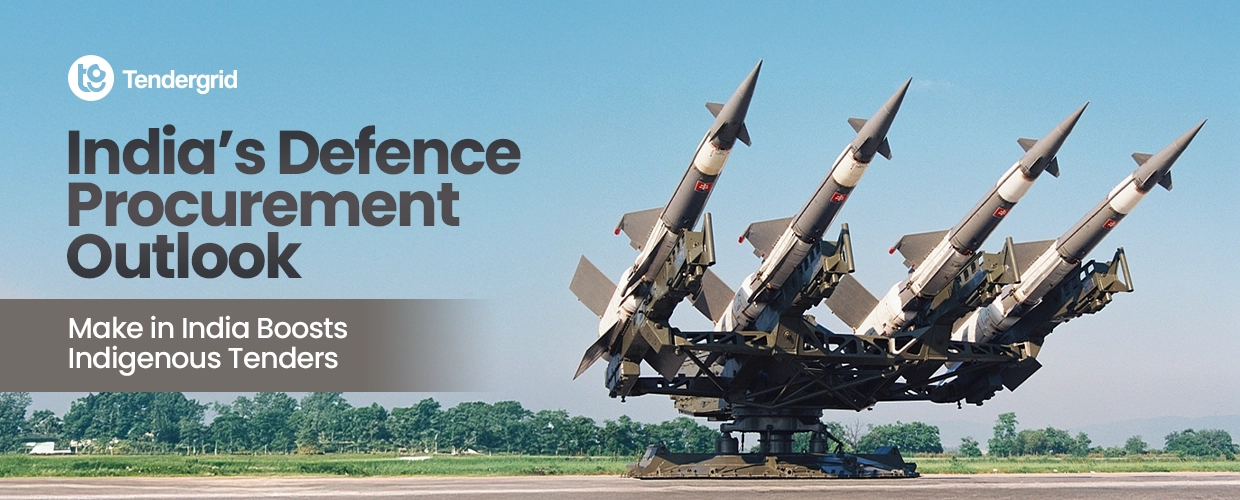With the advent of Make in India initiative in 2014, a clear vision of transforming the nation into a global design and manufacturing hub was also put forward. Earlier, massive adaptation and changes have been noticed in various sectors like automobiles and textiles. However, now is the time when initiatives like defence procurement are starting to make their place in the Indian tender market.
When it comes to the importing of defence equipment, India is counted among the world’s largest importers under this category. It has been noted that around 60-70% of India’s military hardware has been sourced from foreign countries. But at present, the tables are turning, and Ministry of Defence (MoD), along with the Make in India policy, is adopting indigenous manufacturing. This in turn is creating a ground for domestic enterprises to rise through defence tenders. Not only a strategic pivot for national security represented through initiative, but also it transforms the Indian industries, startups, and innovators, in terms of opportunities.
Through this blog, you will get to know how this indigenous wave is shaping the defence procurement outlook. And also how it is effective for the future of Indian military manufacturing.
A Paradigm Shift in Defence Procurement
Earlier, India’s defence system and strategy were mostly dependent upon the foreign Original Equipment Manufacturers (OEMs). But later in the past few years, the policymakers started to rethink the expenditure on the defence system. This idea was later highly supported due to the geopolitical tensions, supply chain vulnerabilities, and the ambition of becoming self-reliant. Defence Acquisition Procedure (DAP) 2020 became an important initiative which supported this idea. The core of this initiative was to support indigenous production and local procurement.
DAP 2020 prioritised Indian firms by introducing several procurement categories, including:
- Buy (Indian-IDDM) – Indigenous design, development and manufacture
- Buy (Indian) – Products manufactured in India with at least 50% original domestic material
- Make-I and Make-II projects – For prototype development by Indian vendors
- Strategic Partnership Model – For building large platforms like submarines and aircraft in collaboration with Indian companies
This, in turn, gave fast growth to both public and private Indian entities who were interested in domestic Defence Tenders.
Tender Grid: Streamlining the Defence Tendering Ecosystem
In India, at present, the market is at a booming stage and businesses often face difficulties while participating in the present tendering system. And facing such difficulties while you think of growing with a better pace must be frustrating. This is where a comprehensive tender-related platform like Tender Grid comes into the picture. This intuitive eTendering portal helps business entities by aggregating, organising, and notifying users about the latest tender-related opportunities. This platform helps users in finding various opportunities in different sectors, which include multiple government departments, such as Ministry of Defence Tenders, DRDO Tenders, and HAL Tenders.
Although it is well known that dealing with defence procurement is a bit challenging process, such eTendering portals come to the rescue for users like us. It proves to be one of the best tools for MSMEs, startups, and even large entities. You will not only be served with real-time alerts, but it will also help you categorise various tenders. The categorisation can be done as per sectors, value, and eligibility, which makes it easier to deal with the tenders in your area of interest.
Defence PSUs Take the Lead: HAL, DRDO and Beyond
When we think about the leading participants in terms of innovation in indigenous defence manufacturing, Hindustan Aeronautics Limited (HAL) and the Defence Research and Development Organisation (DRDO) top the list.
HAL Tenders: Building Wings for India
At present, we can see that HAL is putting efforts in the development of aircraft, helicopters, engines, and avionics systems, on the domestic level. Its efforts and capabilities can be seen in its Tejas Light Combat Aircraft (LCA). This serves as the proud symbol of Indian engineering. HAL is putting efforts in making the whole process completely indigenous. For recent and upcoming projects, it is inviting Indian vendors to participate in its supply chain. The businesses can now easily be a part of its new project in terms of supply for composite materials, control systems, or even advanced sensors.
It is not only limited to the supply of required materials, but interested parties can now even participate in HAL Tenders for co-development of aircraft and other systems through long-term contracts.
DRDO Tenders: Innovation at the Forefront
DRDO is considered India’s supreme entity for research and development under the defence system. Various tenders are being issued by this under different categories such as missile systems, cyber defence, radar tech, and even AI-based surveillance systems. These tenders released by DRDO in this arena have proved to be essential for tech startups and other institutions. This initiative, in turn, helps in building advanced military tech and other solutions related to defence systems.
Private Sector Participation: The Rise of Defence Startups
The participation of private entities took place immensely after the liberalisation of FDI in the defence system. Also, the de-licensing of various defence items boosted this participation. Earlier, SMEs used to face drawbacks due to certain regulations. But, now this issue has been resolved, and the market is now open for all, which is why SMEs are taking the centre stage.
When it is about who is winning contracts in surveillance drones, battlefield imaging, armoured vehicles, and artillery systems? Names of the companies like IdeaForge, Tonbo Imaging, Tata Advanced Systems, and Bharat Forge are considered on top.
The growing number of Ministry of Defence tenders targeted exclusively at Indian startups has also created a new culture of innovation. Incubators and accelerators backed by DRDO and armed forces are helping young entrepreneurs build for the battlefield.
Offset Obligations: A Catalyst for Local Manufacturing
Defence Offset Policy brings advanced technology, tooling, and training into Indian hands. As of now, for winning high-value tenders, foreign original manufacturers are required to invest a part of the contract value back into India. This can be achieved either through co-production, local sourcing, or R&D partnerships.
The ecosystem thus benefits in two ways:
- Domestic vendors gain access to global know-how.
- India reduces its dependence on costly imports over time.
Challenges on the Road to Full Self-Reliance
Some key challenges include:
- Bureaucratic delays in procurement decision-making
- Capacity limitations among small domestic manufacturers
- Export restrictions and dual-use technology complications
- Skill development needed while dealing in specialised fields
These challenges can be effectively dealt through certain policy changes, improved risk-sharing models, and a balanced participation of the public and private sectors.
What Lies Ahead: A Defence Economy in the Making
With the idea of investing approximately 1.5 lakh crore in defence, the Indian government has taken some important initiatives. Under the ‘Positive Indigenisation List’, more than 500 items are already listed, which are to be sourced only from Indian vendors.
This initiative opens new space for more tenders, allows increased public-private partnerships, and enhanced R&D funding for indigenous innovations. And Tender Grid will be at the forefront in order to let interested parties know about the relevant tender-related information.
Conclusion: A New Dawn for Defence Tenders in India
India’s defence procurement landscape is no longer just about buying what the world has to offer. It’s about building what India truly needs, and doing so at home.
Thanks to initiatives like Make in India, institutional support from DRDO and HAL, and smart tools like Tender Grid, the foundation is being laid for a self-sufficient, secure, and innovative defence ecosystem. Defence tenders are no longer the preserve of a few large entities; they’re a call to action for every Indian innovator, manufacturer, and dreamer.
So whether you’re a tech startup crafting AI vision systems, a machining firm with aerospace capability, or a software provider in simulation, now is the time to engage. The mission is national. The opportunity? Boundless.

